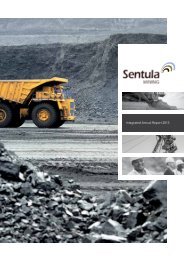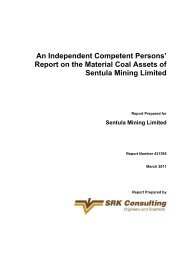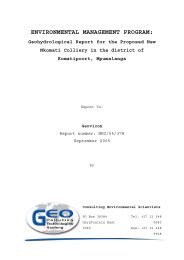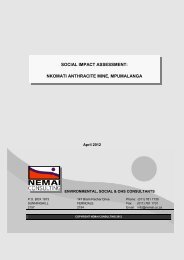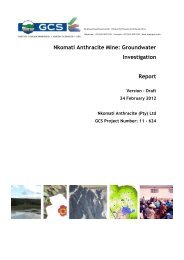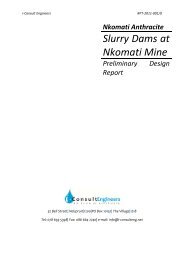NKOMATI ANTHRACITE (PTY) LIMITED - Sentula Mining
NKOMATI ANTHRACITE (PTY) LIMITED - Sentula Mining
NKOMATI ANTHRACITE (PTY) LIMITED - Sentula Mining
Create successful ePaper yourself
Turn your PDF publications into a flip-book with our unique Google optimized e-Paper software.
Environmental Impact Assessment Report: Nkomati Anthracite (Pty) Limited,<br />
Madadeni Opencast <strong>Mining</strong> Project Page 27<br />
3.1.9 G r o u n d w a t e r<br />
Since mining activities can potentially impact on the groundwater, a description of the current<br />
groundwater conditions is required. The purpose of this section is, therefore to describe the prevailing<br />
groundwater conditions. This will serve as a reference baseline for quantifying potential mining<br />
impacts on the existing groundwater regime. Geo Pollution Technologies (Pty.) Ltd. (GPT) was<br />
appointed to conduct a geohydrological study over the proposed Madadeni Opencast mining area and<br />
its surrounds. The outcome of the study is attached as Appendix 3.<br />
3 . 1 . 9 . 1 D e p t h o f G ro u n dw at e r T a b l e<br />
Depth of the groundwater table in the study area was determined by means of a hydrocensus. From<br />
the data it is evident that the groundwater depth varies across the site, mainly due to topography and<br />
heterogeneity of the secondary structures in the bedrock. Groundwater levels varying between 2m<br />
and 20m below ground level were measured during this survey.<br />
Usually a good relationship should hold between topography and static groundwater levels. This<br />
relationship can be used to distinguish between boreholes with water levels at rest, and boreholes<br />
with anomalous groundwater levels due to disturbances such as pumping or local geohydrological<br />
heterogeneities. The relationship using all boreholes is shown in Figure 10.<br />
A contour map of the static groundwater level of the area (Figure 11) was constructed using the<br />
Bayes extrapolated groundwater levels. Groundwater flow direction should be perpendicular to these<br />
contours and inversely proportional to the distance between contours. Using this relationship, the<br />
inferred groundwater flow directions are depicted as Figure 12 below with the length of arrows<br />
proportional to the velocity. As can be expected, the groundwater flow is mainly from topographical<br />
high to low areas, eventually draining to local streams.<br />
3.1.10 P r e s e n c e o f W a t e r Bo r e h o l e s a n d S p r i n g s/ F o u n t a i n s<br />
The calculated groundwater levels were also used to calculate the thickness of the unsaturated zone<br />
(depth to the groundwater level) by subtracting groundwater levels from the topography. Contours of<br />
the unsaturated zone thickness are depicted in Figure 13.<br />
Existing boreholes within and around the proposed mining area were identified during a hydrocensus.<br />
Several boreholes were identified within the vicinity of the proposed Madadeni Opencast <strong>Mining</strong><br />
Project. It was determined during the hydrocensus that most of the identified boreholes are in use.<br />
Locations of the identified boreholes are shown in Figure 14. Only one hydrocensus borehole<br />
(exploration borehole BH10), located on the new proposed mining site, could be sampled for chemical<br />
analysis.<br />
3.1.11 G r o u n d W a t e r Q u a l it y<br />
Water was sampled from the boreholes identified during the hydrocensus and boreholes used for the<br />
groundwater monitoring at the mine. The samples were submitted for major cation and ion<br />
determination to determine the background water quality standards. These chemistry analyses<br />
should serve as baseline water quality throughout the life of the proposed mining operations. The<br />
results from these analyses are contained in Table 13 and compared to the SABS Drinking Water<br />
Standards (SABS 241 Ed. 5).<br />
The groundwater in the area can generally be classified as exceeding maximum allowable drinking<br />
water standards, according to the SABS Guidelines for Drinking Water in terms of the sodium,<br />
magnesium and chloride concentrations.<br />
<strong>NKOMATI</strong> <strong>ANTHRACITE</strong> (<strong>PTY</strong>) <strong>LIMITED</strong><br />
COMPILED BY GEOVICON ENVIRONMENTAL (<strong>PTY</strong>) LTD



